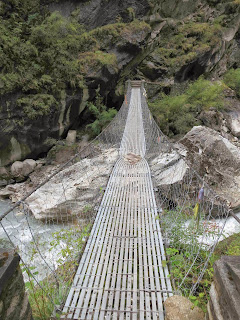Annapurna Trek
Our big trek! Nearly three weeks long. The Annapurna Circuit is a route that opened to foreigners in the late 70s. Originally it started from Pokhara (Karl is still struggling to differentiate his Pokhara from his pakora causing frequent problems) and was a circumnavigation of the Annapurna range. Since then the roads have been extending into the mountains so a lot of the original trek is on a dusty road full of buses and jeeps and so people skip it, doing more of a semi-circumnavigation (or crescent if you prefer) of part of the original route. We took an extremely full bus
playing extremely bad music and getting fuller and fuller as the five hour trip (only about 10km though!) went on. Eventually a woman sat on Karl's lap. I think they were both happy.
We set off with out staff of guide/porters. Tried to be a bit more minimalist this time so just three men and no horses.
Then we started walking from Besisahar and spent a few days on the circuit route before heading north towards the Chinese (Tibetan) border up the Phu and Naar valleys (open to foreigners since about 2000, see separate blog entry), joined back up with the main circuit briefly before heading to Tilicho Lake (see separate entry) and over a short-cut pass down to Jomsom which is where the road gets roady enough again to not be much fun to walk on.
We came across a few interesting bridges which were subject to my "race across before it collapses" technique, much to everyone's amusement. Still don't know if the racing made it more likely to collapse or not but I'm happy to play the statistics.
It's a great trek because you start in the subtropics with rice terraces (more than I ever saw in Bali) and banana plants (sending Karl wild) and you slowly climb up to an alpine landscape with fir trees, then the vegetation becomes less and less until it's just brown dust and then you finally get to snow high up amongst the peaks. Then you keep going and arrive eventually back down in the subtropics.
From low down in the valleys you only occasionally get a glimpse of the peaks as they peek out from the clouds seeming impossibly high and unattainable. You can see why they were seen as the abode of the Gods and the first European climbers who arrived would absolutely have been seen as crazy to think of climbing them.
There's a lovely rhythm to the trek – get up, have a hearty apple-porridge breakfast (which you compare, tea-house to tea-house. The best had generous milk and a sprinkle of cinnamon) with a boiled egg (if you get two you pocket one for morning tea en-route) and milk coffee. Then walk, with some rests, until lunch. On most of the route there's a choice of tea-houses for a hot lunch of fried rice, fried spud, daal bhaat, “spring rolls” (which are actually really good pies) and a yummy selection of teas. Then you walk a couple of more hours to get to your night-time stopover. Settle into your room, have a shower (depending on heat of water, bravery and desperation for shower), do your laundry (socks and knickers in cold water) and kick back with a couple of beers until dinner. Then an early night followed by an early morning feeling remarkably refreshed and ready for anything!
Some rooms let you watch trekkers go by while you're smugly sipping a beer.























Comments
Post a Comment